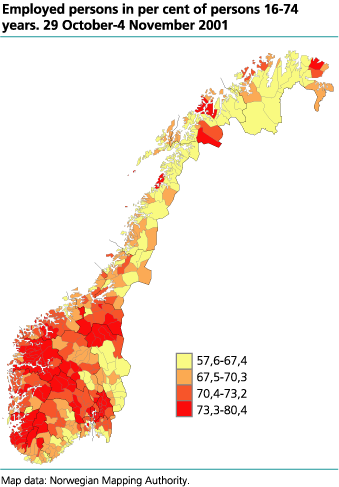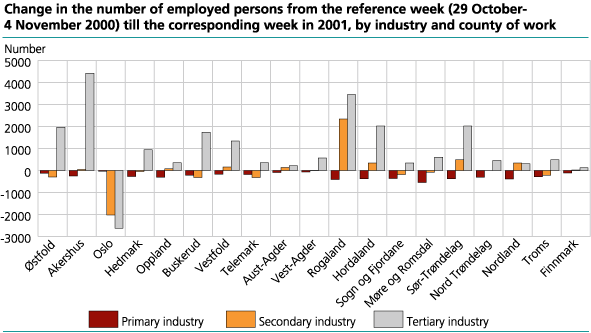Content
Published:
This is an archived release.
Most employed persons in Akershus and Sogn og Fjordane
Akershus and Sogn og Fjordane had the highest proportion of employed persons during census week 2001. There were more men than women employed however, in a few municipalities in Northern Norway, there was a higher proportion of women in employment than men. Many people combine employment and education. Three out of four students were also in employment.
This is illustrated by statistics on employed persons in census week (29 October - 4 November 2001) from the Population and housing census 2001. This publication also marks the beginning of new, annual, register-based employment statistics from Statistics Norway.
Most employed persons in Akershus and Sogn og Fjordane
Akershus has the highest proportion of employed persons, 75.2 per cent, in the age group 16-74 years, followed by Sogn og Fjordane, 74.9 per cent. Akershus has the highest proportion in the age groups below 25 years while Sogn og Fjordane has the highest proportions in the remaining age groups. The counties of Telemark and Aust-Agder have the lowest proportion of employed persons. On the other hand if we look at individual municipalities, we find that 17 of the 20 municipalities with lowest employment per centages are in Northern Norway. Kautokeino has the lowest figure of 57.5 per cent. Oslo is slightly above the national average with a proportion of 71.4 per cent, while there are great differences among the urban districts. Bøler has the lowest figure, 65.3 per cent and St. Hanshaugen-Ullevål has the highest, 78.6 per cent.
Most men in employment in almost every municipality
Among men nation-wide, 74.7 per cent in the age group 16-74 years are in employment while the corresponding figure for women is 66.9 per cent. The employment per centage is higher for men than for women in all counties and municipalities except 9, all of which are located in Northern Norway. 7 of these are in Finnmark. Among municipalities where there are great differences in the proportion of men and women in employment, we find several coastal municipalities as well as a number of agricultural municipalities. Akershus and Sogn og Fjordane have the highest employment per centages for women, 71.8 per cent.
Greatest proportion of women with full-time work in Oslo
There are great variations among the counties as regards the proportion of women with hours of work of 30 hours or more (full-time). Oslo is highest with 73.3 per cent, Vest-Agder and Nord-Trøndelag are lowest with 45.5 and 45.6 per cent respectively. The neighbouring municipalities of Oslo and also coastal municipalities in Finnmark like Båtsfjord, Vardø and Vadsø, are among other municipalities with high proportions. As regards men, there is little variation among the counties. Rogaland has the highest proportion of men in full-time work, 87.0 per cent while Finnmark has the lowest, 83.2 per cent.
Hedmark and Oppland have the highest proportion of persons above 55 years in employment
17.6 per cent of employed persons in Hedmark and Oppland were above 55 years in census week in 2001. This is the highest proportion of persons employed in this age group, compared with the remaining counties. Oslo, Rogaland and Finnmark have the lowest proportions
Most highly educated persons have employment
The proportion employed among persons with higher education is 85.5 per cent. The corresponding figure for persons with upper secondary school as highest completed education is 73.5 per cent. There is little variation among counties for both of these groups. Among persons with primary school level as highest completed education, only 45.8 per cent are in employment. There are also great discrepancies here among the counties, from just over 40 per cent in Aust-Agder and Nord-Trøndelag to almost 54 per cent in Akershus. In interpreting the figures, it is important to bear in mind that persons with highest completed education at primary school level have a relatively high average age and further, older persons have lower employment proportions than younger persons. This is clearly illustrated when we look at persons with 7-year primary school education, of whom only 25 per cent are in employment.
Many combine employment with education
About 75 per cent of all persons registered as students at universities and colleges are also in employment. 38.2 per cent of pupils in upper secondary schools and folk high schools are in employment. Only 16.9 per cent of these pupils work full-time, while the figure for the students is 42.2 per cent. The proportion in employment for 16 year-old pupils/students is 20.4. This figure rises with each successive year and reaches 65.3 per cent for 20 year-olds. For the age groups above 20 years, employment is at about 70 per cent. Half of the school pupils work in domestic trade, hotel and restaurant enterprises, while 21.5 per cent of the students work in this industry. About just as much (22.7 per cent) of the students are employed in health care and social services. It is worth noting that the group pupils/students does not only comprise those who have education as their primary activity but also persons taking supplementary education related to their work, for example.
New annual, register-based employment statistics
The new register-based employment statistics will be an important supplement to employment figures from the Labour Force Survey, especially for regional figures. The statistics are published for the first time as a part of the census 2001, and will be published annually. Figures for the years 2000 and 2001 are now available. For the annual statistics, the times series are the most important issue. We now present the changes from 2000 to 2001.
From 2000 to 2001: Increase in business services, decrease in primary industries
In census week (29 October - 4 November) in 2000 until the same week in 2001, the industry with the greatest increase of employed persons was business activities and real estate, with an increase of 11 338 or 5.1 per cent. All the counties of the country experienced growth in this industry; Rogaland had the greatest growth. There was also an increase in the number of employed persons in health care and social services. The counties of Troms, Akershus and Sør-Trøndelag had the greatest increase. All counties had a decline in the number of employed persons in the primary industries. For the nation as a whole, the number of wage earners and self-employed decreased by 4 931 persons, or 5.5 per cent. The greatest decline in per centage was in Telemark and Akershus with 9.1 and 7.5 per cent respectively. In absolute figures, the decline in primary industries was greatest in Møre og Romsdal and Rogaland, particularly in agriculture.
Tables:
- Table 1 Persons 16-74 years, by employment, sex and highest completed education. 29 October-4 November 2001. Numbers and per cent
- Table 2 Employed persons 16-74 years, by immigrant population's country, sex, age and education level. 29 October-4 November 2001. Numbers and per cent of all persons in each group
- Table 3 Pupils and students 16-74 years, by employment, sex, age and type of school. 29 October-4 November 2001. Numbers and per cent
- Table 4 Employed persons 16-74 years total and pupils 2, by settled/usual working hours per week and industry. 29 October-4 November 2001. Numbers and per cent
- Table 5 Persons 16-74 år, by employment, highest completed education, place of residence, county, municipality and urban district. 29 October-4 November 2001. Numbers and per cent of all persons i each group
- Table 6 Persons 16-74 years, by employment, sex, place of residence, county, municipality and urban district. 29 October-4 November 2001. Numbers and per cent
- Table 7 Employed persons 16-74 years, by age, place of residence, county, municipality and urban district. 29 October-4 November 2001. Per cent of all persons in each group
- Table 8 Employed persons 16-74 år, by sex, settled/usual working hours per week, place of residence, county, municipality and urban district. 29 October-4 November 2001. Per cent
- Table 9 Employed persons 16-74 years, by industry, place of residence, county, municipality and urban district. 29 October-4 November 2001. Per cent
- Table 10 Employed persons 16-74 år, by sex, settled/usual working hours per week, place of work, county, municipality and urban district. 29 October-4 November 2001. Per cent
- Table 11 Employed persons 16-74 years, by industry, place of work, county, municipality and urban district. 29 October-4 November 2001. Per cent
- Table 12 Employed persons 16-74 år, by sector, place of work, county, municipality and urban district. 29 October-4 November 2001. Numbers and per cent
- Table 13 Employed persons 16-74 years, by sex, status in employment, place of work, county, municipality and urban district. 29 October-4 November 2001. Numbers and per cent
- Table 14 Employed persons 16-74 år, by number of employed persons in the establishment, place of work, county, municipality and urban district. 29 October-4 November 2001. Per cent
- Table 15 Pupils and students 16-74 years, by employment and place of school. County and selected municipalities. 29 October-4 November 2001. Numbers and per cent
- Table 16 Persons 16-74 years, by employment, sex and county of residence. 29 October-4 November 2000 and 2001. Numbers and per cent
- Table 17 Employed persons 16-74 years, by age and county of residence. 29 October-4 November 2000 and 2001
- Table 18 Employed persons 16-74 years, by age and county of residence. 29 October-4 November 2000 and 2001. Per cent of population
- Table 19 Employed persons 16-74 years, by age and county of residence. 29 October-4 November 2000 and 2001. Per cent
- Table 20 Employed persons 16-74 years, by age and county of residence. Males. 29 October-4 November 2000 and 2001. Per cent
- Table 21 Employed persons 16-74 years, by age and county of residence. Females. 29 October-4 November 2000 and 2001. Per cent
- Table 22 Employed persons 16-74 years, by sex, settled/usual working hours per week. 29 October-4 November 2000 og 2001. Per cent
- Table 23 Employed persons 16-74 years, by age, settled/usual working hours per week. 29 October-4 November 2001. Per cent
- Table 24 Employed persons 16-74 years, by sex, county of work and industry division. 29 October-4 November. 2000 and 2001
- Table 25 Employed persons 16-74 years, by sex and county of work. 29 October-4 November 2001. Numbers and per cent
- Table 26 Employed persons 16-74 years, by sex, settled/usual working hours per week and industry division. 29 October-4 November 2001. Per cent
- Table 27 Employed persons 16-74 years, by age and industry division. 29 October-4 November 2001. Per cent
- Table 28 Employed persons 16-74 years by sector and industrial division. 29 October-4 November 2002. Numbers. (New table was released 12 February 2003)
Contact
-
Statistics Norway's Information Centre
E-mail: informasjon@ssb.no
tel.: (+47) 21 09 46 42


